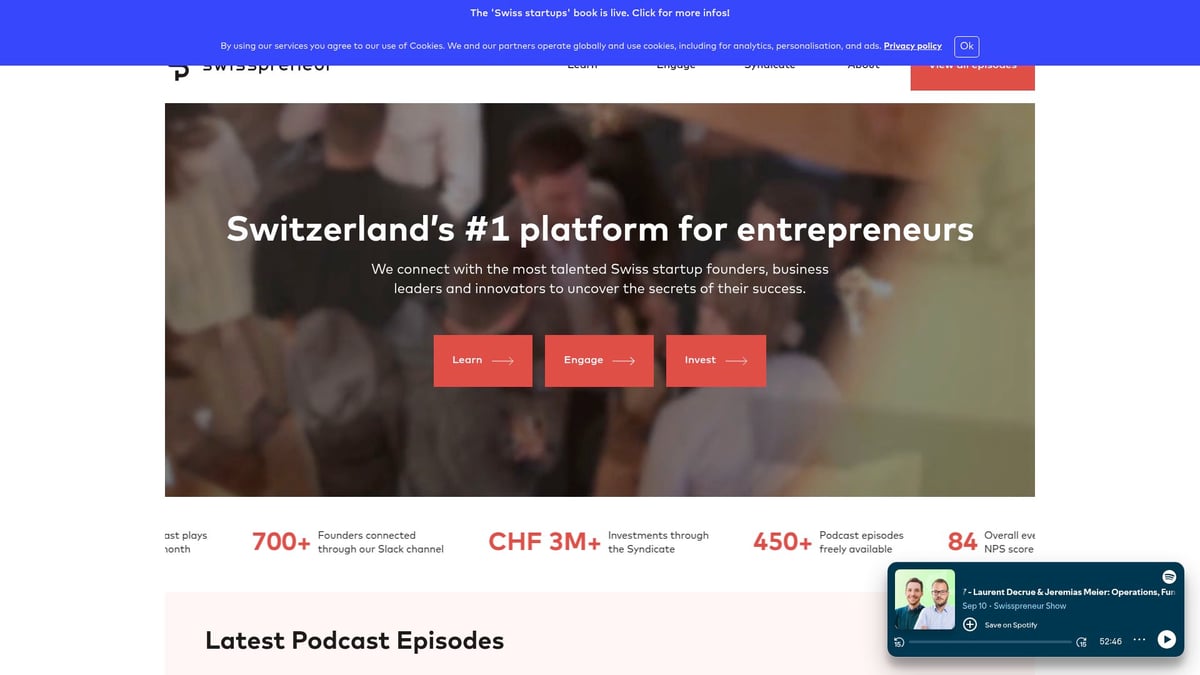Business New Business Guide: Your 2025 Success Blueprint
Ready to launch a thriving business new business in 2025? The landscape is shifting fast, and those who prepare today will shape tomorrow’s success stories.
This guide is your step-by-step blueprint for turning ambition into action. Whether you’re refining an idea or scaling up, you’ll find proven strategies tailored for the 2025 market.
Discover how to validate your idea, design a winning plan, leverage digital tools, secure funding, build a resilient team, and future-proof your company. Let’s dive in and turn your dream into reality.
Step 1: Identifying Winning Business Ideas for 2025
Finding the perfect business new business idea for 2025 is about more than inspiration. It’s about tuning in to what’s next, understanding how markets are shifting, and making smart, data-driven choices. Let’s break down exactly how you can spot, validate, and refine your business new business concept for the coming year.

Understanding 2025 Market Trends
To launch a standout business new business, you need to know where the world is heading. In 2025, industries like AI, sustainability, healthtech, and remote services are booming. Post-pandemic consumer habits have shifted—people want tech-enabled, flexible solutions. According to Statista, 61% of new ventures in 2024 focused on tech-driven business new business models. The rise of AI-driven SaaS startups is proof that innovation is rewarded. If you stay on top of these trends and adapt your business new business vision, you’ll gain a real edge over competitors moving into 2025.
Validating Your Business Idea
Before you go all-in, ensure your business new business idea truly solves a problem. Use market research: surveys, MVPs, and competitor analysis are key. Tools like Google Trends, SEMrush, and customer interviews reveal what people actually want. For example, one founder launched an MVP and secured $50K in pre-sales before scaling up. To master this stage, study the Dos and don'ts of startup idea testing for practical insights on how to refine your business new business and avoid costly missteps.
Niche Selection and Differentiation
A focused niche makes your business new business easier to market and more likely to succeed. Startups that zero in on micro-niches—like D2C brands targeting specific hobbies—often outperform broader competitors. The secret is a unique value proposition: what makes your business new business stand out? Craft messaging that highlights your strengths and solves a specific pain point. By narrowing your audience, you create loyal fans and reduce competition. Remember, in 2025’s crowded markets, a razor-sharp niche can turn your business new business into an industry leader.
Assessing Market Demand and Scalability
To build a scalable business new business, dive into demand models like TAM (Total Addressable Market), SAM (Serviceable Available Market), and SOM (Serviceable Obtainable Market). Use analytics to forecast growth and spot trends. Subscription box companies, for example, have scaled rapidly by leveraging digital marketing and data insights. Consider this: can your business new business expand regionally or globally? If so, map out the steps early. Scalability isn’t just about growth—it’s about building a business new business that can weather change and seize new opportunities.
Avoiding Common Pitfalls
Even the best business new business ideas can fail if you overlook major risks. Overcrowded markets, skipping validation, or ignoring customer feedback are frequent traps. According to CB Insights, 35% of startups fail because there’s no market need for their product. A classic case: a social app that launched without user research and fizzled quickly. The lesson? Validate every step, listen to feedback, and keep refining your business new business. Learning from others’ mistakes is the fastest way to avoid becoming a statistic.
Step 2: Building a Robust Business Plan and Strategy
A well-crafted business plan is your roadmap for launching and scaling a business new business in 2025. Today’s fast-moving market demands a plan that’s not just thorough, but also adaptable and grounded in real data. Let’s break down each critical element you need to build a resilient foundation.

Key Elements of a 2025-Ready Business Plan
Every business new business needs a plan that covers all the bases. Start with an executive summary that captures your vision and value. Dive deep into market analysis—who are your competitors, and what gaps can you fill?
Include clear product or service details, pricing, and go-to-market strategies. Financial projections are a must, but today’s plans also need ESG (Environmental, Social, Governance) considerations to attract investors and meet evolving regulations. For a step-by-step breakdown, see this How to start a business guide.
Setting SMART Goals and KPIs
To keep your business new business on track, set SMART (Specific, Measurable, Achievable, Relevant, Time-bound) goals. Define your key performance indicators (KPIs)—think monthly recurring revenue (MRR), customer acquisition cost (CAC), and churn rate if you’re SaaS.
Companies that track KPIs are 30% more likely to achieve their targets. Regularly review these metrics to course-correct quickly and celebrate wins. Remember, clear objectives keep your team focused and motivated.
Crafting a Flexible Business Model
A business new business must stay agile. Use lean startup principles: build, measure, learn, and pivot as needed. Your business model should allow for quick adjustments in response to market changes or customer feedback.
Look at the food delivery sector post-pandemic; those who shifted business models rapidly thrived. Test new revenue streams, pricing models, or distribution channels. Flexibility is your secret weapon in a changing world.
Risk Management and Contingency Planning
Every business new business faces risks—financial, operational, and market-related. Identify potential pitfalls early: What if your main supplier fails? What if demand shifts overnight?
Develop contingency plans for each risk. For example, e-commerce brands in 2023-24 faced logistics bottlenecks and survived by diversifying suppliers. Keep backup plans ready, and review them regularly with your team. Proactive risk management protects your bottom line.
Leveraging Digital Tools for Planning
Digital tools can supercharge your business new business planning. Platforms like LivePlan help you map out strategies, while Notion and Trello keep teams organized and accountable.
Artificial intelligence is now powering forecasting and scenario planning, making it easier to anticipate market shifts. For example, AI-driven process optimization helps streamline operations and spot growth opportunities early. Choose tools that fit your workflow and scale as your business grows.
Step 3: Securing Funding and Financial Foundations
Launching a business new business in 2025 means building a rock-solid financial foundation from day one. The right funding strategy and financial management approach can be the difference between scaling fast or stalling early.
No matter your industry, understanding funding options, mastering your pitch, and maintaining financial health are essential. Let’s break down each step to help you secure the capital and confidence to grow your business new business.

Exploring Funding Options for Startups
When launching a business new business, your funding strategy sets the tone for growth. Many founders begin with bootstrapping, using personal savings to cover early costs. In fact, 38% of startups use this approach, according to the Kauffman Foundation.
Other options include seeking angel investors who provide capital in exchange for equity, or pitching to venture capitalists for larger funding rounds. Crowdfunding platforms can also help validate your idea while raising money from early supporters.
Compare your options:
| Funding Source | Pros | Cons |
|---|---|---|
| Bootstrapping | Full control, no dilution | Limited resources |
| Angel Investors | Guidance, network access | Share equity |
| Venture Capital | Large capital, rapid scaling | High expectations |
| Crowdfunding | Market validation, no equity loss | Marketing effort required |
Choosing the right mix is crucial for your business new business journey.
Preparing a Winning Pitch Deck
To attract investors to your business new business, you need a compelling pitch deck. Think of it as your story in slides—concise, data-driven, and visually engaging.
Include the essentials:
- Problem: What gap does your business new business fill?
- Solution: Your unique approach.
- Traction: Early wins or user growth.
- Team: Key players and expertise.
- Financials: Revenue projections and funding needs.
Take inspiration from Airbnb’s original pitch deck—simple, clear, and focused on value. Practice your pitch until it’s second nature. Tailor it for each investor, highlighting how your business new business stands out in today’s dynamic market.
Managing Cash Flow and Financial Health
A healthy cash flow is the lifeblood of any business new business. Without it, even the best ideas can falter. In fact, 82% of failed startups cite cash flow issues as the main culprit.
Use tools like QuickBooks, Xero, or Wave to track expenses, forecast revenue, and manage invoices. Regularly review your financial statements to spot trends and act fast if issues arise.
For more hands-on guidance, check out Finance essentials for startups to help your business new business avoid common financial pitfalls and set up smart systems from the start.
Navigating Grants, Loans, and Incentives
Don’t overlook grants, loans, and government incentives when funding your business new business. Many countries offer innovation grants or small business loans to encourage entrepreneurship.
For example, the EU’s Horizon 2020 initiative has helped tech startups secure vital funds. Research what’s available in your region—local banks, economic development agencies, and startup support organizations often list active programs.
Prepare thorough applications, emphasizing how your business new business aligns with grant criteria or loan requirements. A little extra research can unlock resources you never expected.
Building Investor Relationships
Fundraising isn’t just about the ask—it’s about building trust. Successful business new business founders nurture relationships with investors well before they need capital.
Start by networking at industry events, joining startup communities, and connecting on platforms like LinkedIn. After meetings, send thoughtful follow-ups and regular updates about your progress.
Case in point: a startup that raised $1M did so by keeping investors engaged through consistent, transparent communication. Remember, investors back people as much as ideas, so let your passion for your business new business shine through every interaction.
Step 4: Assembling and Leading a High-Performance Team
Building a high-performance team is the heartbeat of any business new business aiming for 2025 success. The right people, roles, and culture will set your venture apart in a competitive landscape. Let’s break down how you can assemble a dynamic team and lead them to victory.
Defining Key Roles for Startup Success
The foundation of a business new business is its team. Identifying the essential roles early ensures you cover all critical functions.
- Co-founder: Shares vision, divides leadership, and balances skills.
- CTO/Technical Lead: Oversees product development and tech strategy.
- Marketing Lead: Drives brand awareness and customer acquisition.
- Sales Lead: Converts leads and builds revenue streams.
Startups with complementary founding teams raise 25% more funding, highlighting the value of balanced expertise. For a deeper dive into team dynamics and success rates, explore the Comprehensive startup statistics for 2025. By defining roles thoughtfully, you give your business new business a solid launchpad.
Recruiting and Retaining Top Talent
Attracting and keeping top talent is essential for your business new business to thrive. In 2025, employer branding and remote hiring will be more important than ever.
Offer a compelling employee value proposition—think flexible work, growth opportunities, and a mission-driven culture. Use global job boards and social media to reach talent beyond borders.
Remote-first startups have tapped into worldwide expertise, often outpacing local competitors. Provide clear career paths and recognize achievements to boost retention. Remember, a business new business grows as its people grow.
Fostering a Winning Company Culture
A strong company culture is the backbone of every business new business. Lead with values that inspire: transparency, inclusion, and innovation.
Diversity drives results. According to McKinsey, diverse teams outperform by 35%. Create an environment where everyone’s voice matters, and different perspectives are celebrated.
Encourage regular team check-ins and open feedback loops. Support social initiatives and community engagement to strengthen bonds. When culture thrives, your business new business attracts—and keeps—the best.
Leadership and Team Development Strategies
Leadership in a business new business is about more than giving orders; it’s about nurturing growth. Invest in coaching and mentorship to uplift your team.
Host weekly learning sessions or workshops to encourage continuous improvement. Pair new hires with experienced mentors for smoother onboarding.
Encourage open communication and set clear goals. Recognize strengths and provide constructive feedback. When leaders model learning and resilience, the whole business new business benefits.
Managing Remote and Hybrid Teams
Managing teams across locations is now the norm for any forward-thinking business new business. Use tools like Slack, Asana, and Zoom to keep everyone connected and productive.
Set expectations for communication—daily standups, weekly check-ins, and transparent updates help maintain alignment. Encourage team bonding with virtual coffee chats or online games.
Hybrid and remote teams can achieve high engagement and output by prioritizing trust and flexibility. With the right systems, your business new business can thrive—no matter where your team is based.
Step 5: Launching, Marketing, and Scaling Your Business
Launching a business new business in 2025 means more than just opening your doors and hoping for the best. Success comes from structured planning, smart marketing, and a relentless focus on customer value. Here’s your step-by-step guide to go from launch to scale, built for today’s fast-moving startup environment.
Creating a Go-to-Market Strategy
Your go-to-market strategy sets the stage for your business new business launch. Start with a soft launch or beta testing to gather feedback without overwhelming your resources. Early adopters can help iron out kinks before a full-scale release.
Leverage influencer seeding to create buzz and reach niche audiences. For SaaS startups, a beta launch can generate thousands of signups and invaluable insights. Map out your customer journey from discovery to purchase, ensuring every touchpoint is seamless and memorable.
A clear go-to-market plan gives your business new business the momentum it needs to make a splash in a crowded market.
Digital Marketing Essentials for 2025
Digital marketing is where your business new business will find its first fans and loyal customers. Focus on SEO to get discovered in search, and use content marketing to build authority. Paid ads and social media, especially emerging platforms, amplify your reach.
Did you know that 72% of consumers now discover new brands online? This stat, along with more insights from the Startup success rates and key statistics, highlights the importance of a digital-first approach.
Consider this quick comparison table for your digital marketing toolkit:
| Channel | Tool Example | Goal |
|---|---|---|
| SEO | SEMrush | Organic traffic |
| Paid Ads | Google Ads | Quick reach |
| Social Media | TikTok, LinkedIn | Brand engagement |
Keep testing and iterating to see what works best for your business new business.
Building Your Brand and Online Presence
Your business new business needs a memorable brand story and a standout online presence. Start with a sharp visual identity—logo, color palette, and design elements that reflect your mission.
Optimize your website for mobile, speed, and SEO. Create a compelling About page and showcase customer testimonials. DTC brands are leveraging platforms like TikTok for viral growth, proving that creative storytelling can set you apart.
Consistency across all channels builds recognition and trust. Make sure your branding and messaging resonate with your target audience and evolve as your business new business grows.
Leveraging Automation and AI in Marketing
Automation and AI are game-changers for marketing a business new business. Chatbots handle customer queries 24/7, while personalized email campaigns keep leads engaged. AI-driven analytics uncover patterns in customer behavior, helping you fine-tune your strategies.
For example, e-commerce brands have seen ROI increases of 30% by integrating AI tools into their marketing stack. Automate repetitive tasks to free up time for creative work and strategic planning.
Adopt a test-and-learn mindset. The right automation tools will scale with your business new business, making growth more manageable and efficient.
Customer Acquisition and Retention Strategies
Acquiring customers is only half the battle for any business new business. Retention is the real growth engine. Launch referral programs to tap into existing customers’ networks, and reward loyalty with exclusive perks.
Customer success teams play a pivotal role in keeping users happy and engaged. Remember, increasing retention by just 5% can boost profits by up to 95%. This makes investing in customer relationships one of the smartest moves you can make.
Focus on delivering value at every touchpoint, and your business new business will see higher lifetime value from every customer.
Scaling Operations and Expanding Market Reach
When your business new business gains traction, it’s time to scale. Explore new markets through internationalization or by forming strategic partnerships. Extend your product line to meet evolving customer needs.
Many SaaS companies have expanded into the EU by partnering locally, leveraging regional expertise. For a global perspective on scaling, the Global startup ecosystem report 2023 offers valuable benchmarks and trends.
Stay agile, monitor metrics closely, and be ready to pivot. Sustainable scaling is the hallmark of a thriving business new business.
Step 6: Future-Proofing Your Business for Long-Term Success
Staying ahead in the business new business landscape means never standing still. The most successful founders know that future-proofing isn’t a one-time task—it’s a continuous journey. In this step, we’ll explore how to keep your business new business resilient, adaptable, and geared for long-term growth.
Embracing Innovation and Continuous Improvement
To future-proof any business new business, foster a culture where experimentation is the norm. Encourage your team to challenge assumptions and run rapid prototyping sessions. Design sprints are an effective way for business new business founders to test new ideas quickly and learn from real feedback.
- Hold monthly innovation workshops
- Celebrate “failures” as learning opportunities
- Use customer input to guide changes
Companies that prioritize continuous improvement are more likely to spot opportunities and stay ahead of competitors. Make innovation a core value for your business new business.
Adapting to Regulatory and Technological Changes
The regulatory environment for a business new business evolves rapidly. New tech laws, like GDPR updates or emerging AI regulations, require founders to stay vigilant. In 2024, 60% of companies updated their policies due to technological advancements.
Here’s a quick table to help your business new business track major changes:
| Area | 2025 Focus |
|---|---|
| Data Privacy | AI & consumer data |
| Sustainability | ESG reporting |
| Employment | Remote work laws |
Proactively adapting your business new business to these shifts prevents costly setbacks and builds customer trust.
Sustainability and Social Responsibility
Integrating ESG (Environmental, Social, Governance) into your business new business isn’t just ethical—it drives growth. Consumers and investors now favor companies committed to positive impact.
Consider these actions for your business new business:
- Measure your carbon footprint
- Set diversity and inclusion goals
- Pursue certifications like B Corp
For many, adopting ESG practices has become a major growth driver. Make social responsibility part of your business new business DNA.
Leveraging Data and Analytics for Decision Making
Today’s business new business leaders rely on real-time dashboards and predictive analytics to guide every decision. Whether it’s optimizing inventory or forecasting demand, data is your best ally.
Set up analytics tools that let your business new business:
- Track key performance indicators
- Identify customer trends
- Test new strategies with A/B experiments
A data-driven mindset helps your business new business pivot quickly and seize new opportunities.
Building Resilience in Uncertain Times
Unexpected events can disrupt even the best business new business. Scenario planning and agile operations are essential to weather any storm. For instance, restaurants that pivoted to delivery models during crises survived and even thrived.
Resilience strategies for your business new business include:
- Diversifying revenue streams
- Creating contingency plans
- Maintaining strong cash reserves
Learning from startup failure rates and causes can help your business new business avoid common pitfalls and build a more robust foundation.
Networking and Community Engagement
No business new business succeeds in isolation. Building relationships with other founders, mentors, and investors unlocks valuable opportunities. Industry events, online forums, and masterminds are powerful tools.
According to research, 80% of business leaders attribute major breakthroughs to networking. Learn more about the importance of community in building a startup community first, and make engagement a core part of your business new business strategy.
Swisspreneur: Empowering Swiss Startup Success
Swisspreneur stands as Switzerland’s leading platform for business new business founders. Offering free masterclasses, insightful podcasts, and regular events, Swisspreneur connects you with a vibrant network of over 700 founders and 1,000 investors.

The platform’s investment syndicate has channeled over CHF 3M into Swiss startups. Unique tools like the Swiss Startup Mafia Map provide unmatched ecosystem visibility. For business new business leaders, Swisspreneur delivers founder-led insights and real-world advice for sustainable growth.
Measuring Progress and Setting New Milestones
Consistent tracking drives business new business growth. Schedule regular performance reviews and use OKRs (Objectives and Key Results) to keep your team aligned.
Successful business new business founders use quarterly reviews to spot trends and pivot as needed. According to McKinsey, companies with structured review processes grow 30% faster. Make milestone tracking a habit, and your business new business will always move forward.
Launching a business in 2025 is all about learning from those who’ve been there and done it—real founders, real stories, real lessons. That’s exactly what Swisspreneur brings to the table: candid conversations with Switzerland’s top entrepreneurs who’ve navigated the same challenges you’re about to face. If you want practical insights, honest advice, and a behind-the-scenes look at what actually works, I highly recommend you listen to our podcast. It’s like having a mentor in your pocket as you build your own success story—don’t miss out on this resource!

